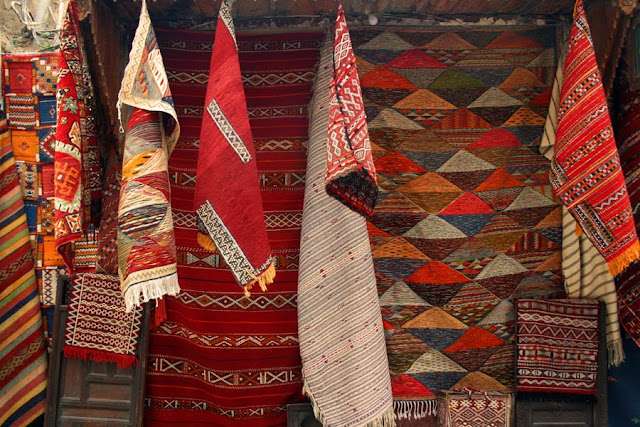A Guide to Moroccan Carpets: Patterns, Colors, and Where to Buy
Moroccan carpets, known for their unique craftsmanship and rich cultural heritage, have captivated collectors, designers, and travelers for centuries. Handwoven by Berber women, these rugs are not only decorative pieces but also carry deep cultural significance, with each pattern, symbol, and color telling a story. Whether you’re looking to buy one for your home or are simply curious about the art form, this guide will help you understand the various types of Moroccan carpets, their meanings, and where to find authentic ones.
1. Types of Moroccan Carpets
Moroccan carpets vary greatly depending on the region, tribe, and purpose. Each type of carpet has distinctive characteristics that reflect the environment, traditions, and resources of the weavers. Here are some of the most popular types:
Beni Ourain Carpets
Beni Ourain rugs, perhaps the most famous of all Moroccan carpets, come from the Atlas Mountains. Known for their neutral colors, these rugs typically feature a cream or white background with simple black or brown geometric designs. Beni Ourain carpets are made from high-quality wool, making them incredibly soft and durable.
- Key Features: Neutral tones, diamond or geometric patterns.
- Best For: Minimalist or modern interior designs.
Azilal Carpets
Hailing from the Azilal province in the central High Atlas Mountains, these carpets are vibrant and artistic. Unlike the monochrome Beni Ourain rugs, Azilal carpets incorporate bright, bold colors and abstract patterns, often reflecting the personal stories and symbols of the weaver.
- Key Features: Bright colors, asymmetrical patterns, and creative designs.
- Best For: Adding a splash of color and a bohemian feel to any space.
Boucherouite Carpets
Boucherouite rugs are known for their eclectic use of recycled materials like cotton, nylon, and wool. Originating from rural Berber villages, these carpets are highly expressive and often made from scraps of fabric, resulting in a colorful and playful design. Each Boucherouite rug is unique, showcasing the creativity of its maker.
- Key Features: Made from mixed materials, colorful, and patchwork-like.
- Best For: Eclectic, modern, or casual interiors.
Zemmour Carpets
Zemmour rugs are made by Berber women in the Middle Atlas region and are known for their intricate, symmetrical designs. These carpets often feature vibrant red backgrounds with geometric motifs in contrasting black, white, and orange.
- Key Features: Red background, geometric shapes, dense patterns.
- Best For: Traditional or vintage-inspired home decor.
R’Bati Carpets
Originating from Rabat, R’Bati carpets are distinct in their royal elegance. Traditionally crafted for Moroccan nobility, these carpets have a refined look, often featuring bold, central medallions on a bright red or dark blue background. They’re made with high-quality wool and have a thick, luxurious pile.
- Key Features: Bold central designs, red or blue backgrounds, and floral motifs.
- Best For: Formal or regal interior settings.
2. Symbolism and Patterns in Moroccan Carpets
The patterns and symbols woven into Moroccan carpets have significant cultural meanings, often representing aspects of life such as fertility, protection, and spirituality. Here are some common symbols:
- Diamond Shape: Represents protection from evil spirits.
- Triangles: Often symbolize fertility or growth.
- X’s and Crosses: Used to represent harmony and balance.
- Zigzag Lines: Signify water or the flow of life, reflecting the importance of water in desert regions.
Each rug is a personal expression of the weaver’s experiences and worldview, making every piece a one-of-a-kind work of art.
3. Colors and Their Meanings
The colors used in Moroccan carpets also carry symbolic weight, often derived from natural dyes made from plants, minerals, and insects. The meanings of these colors can vary slightly between tribes, but here are some general interpretations:
- Red: Symbolizes strength, protection, and life.
- Blue: Represents wisdom, tranquility, and the sky.
- Green: Associated with nature, fertility, and peace.
- Yellow: Represents eternity and the sun, often symbolizing happiness and prosperity.
- Black: Signifies resilience and protection.
4. Where to Buy Moroccan Carpets
Finding authentic Moroccan carpets can be a rewarding experience, whether you’re shopping in Morocco or from abroad. Here are some of the best places to purchase authentic rugs:
1. Souks and Markets
The bustling markets (souks) of cities like Marrakech, Fes, and Essaouira are some of the most popular places to buy Moroccan carpets. The Marrakech Medina and Souk el Henna in Fes offer a wide selection of carpets from different regions of Morocco. When buying from a souk, be prepared to bargain – haggling is part of the shopping experience!
2. Carpet Cooperatives
If you’re looking for a more ethical purchase, consider visiting a carpet cooperative. These cooperatives ensure that the weavers are paid fair wages and often reinvest profits into the local community. The Association Tissage Tiwaline in the Middle Atlas Mountains is an excellent example of a cooperative where you can find beautifully made rugs while supporting local artisans.
3. Specialty Carpet Shops
In addition to the souks, there are numerous independent shops that specialize in Moroccan carpets. These stores often carry high-quality, curated selections and may offer shipping services if you’re buying from abroad. Dar Zemmour in Marrakech and La Maison Berbere in Rabat are two well-known shops with a reputation for selling authentic rugs.
4. Online Retailers
If you can’t make it to Morocco, many reputable online retailers specialize in authentic Moroccan carpets. Websites like Etsy and Le Souk offer a wide range of handmade Moroccan rugs, often directly from Moroccan artisans.
5. Tips for Buying Moroccan Carpets
- Authenticity: Make sure to ask questions about the origin of the rug and the materials used. Handmade rugs from wool are more valuable than machine-made or synthetic versions.
- Bargaining: In Moroccan markets, bargaining is expected. Start by offering about 50-60% of the initial asking price and work your way up from there.
- Size: Moroccan carpets come in various sizes, from small accent pieces to large room-sized rugs. Measure your space beforehand to ensure you purchase the right size.
- Shipping: If you’re buying a large carpet, most vendors offer shipping services. Be sure to ask about the cost and time frame for delivery.
Conclusion
Moroccan carpets are more than just decorative items; they are a piece of history and culture woven into wool. Whether you’re drawn to the minimalist designs of Beni Ourain rugs or the bold colors of Azilal carpets, each one tells a story that adds depth and character to your home. By understanding the patterns, colors, and origins of these carpets, you’ll be better equipped to find the perfect piece that resonates with you and your style. Happy shopping!





